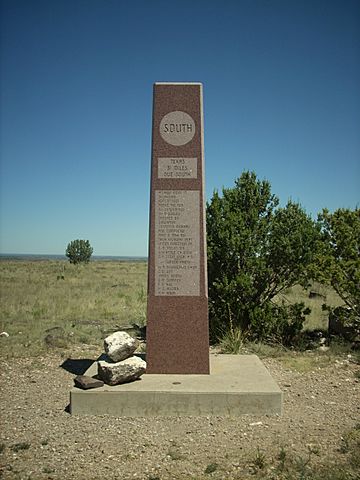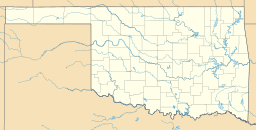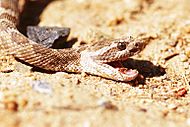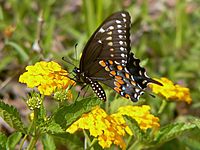Black Mesa facts for kids
Quick facts for kids Black Mesa |
|
|---|---|

Black Mesa, highest point in Oklahoma
|
|
| Highest point | |
| Elevation | 4,973 ft (1,516 m) |
| Listing | U.S. state high point 23rd |
| Geography | |
| Topo map | USGS Jacks Gap |
| Geology | |
| Mountain type | Mesa |
| Climbing | |
| Easiest route | Hike |
Black Mesa is a flat-topped hill, called a mesa, that stretches across parts of Colorado, New Mexico, and Oklahoma in the United States. It starts in Colorado and goes southeast for about 28 miles (45 km). It crosses the northeast corner of New Mexico and ends near Kenton in the Oklahoma Panhandle.
The highest point of Black Mesa in Colorado is 5,705 feet (1,739 meters) high. In New Mexico, its highest point is 5,239 feet (1,597 meters). In Oklahoma, Black Mesa reaches 4,973 feet (1,516 meters). This makes it the highest point in the state of Oklahoma!
This special plateau is known for its amazing geology and unique wildlife. You can find animals like mountain lions, many kinds of butterflies, and even the Texas horned lizard living here.
Contents
A Look at Black Mesa's Past
The Black Mesa area has a long and interesting history.
Who Lived Here Before?
Long ago, Plains Indians called this plateau home. They lived and hunted in this region for many years.
Outlaws and New Settlers
In the late 1800s and early 1900s, Black Mesa was a hiding spot for people who broke the law. These "outlaws" included famous figures like William Coe and Black Jack Ketchum. They even built a stone fort called the Robbers' Roost. This fort had a blacksmith shop, places to shoot from, and even a piano!
At that time, the Oklahoma Panhandle was a "no man's land" without much law enforcement. This made it a safe place for outlaws to hide. But as more people moved to the area, looking for copper and coal, or to raise cattle, law enforcement became stronger. This helped to bring the outlaws under control.
Exploring Black Mesa's Geography
Black Mesa is located in Cimarron County, Oklahoma in the Oklahoma Panhandle. It's part of the Rocky Mountains and a type of grassland called a shortgrass prairie.
What Does Black Mesa Look Like?
The mesa has some cool features, like Old Maid Rock and Devil's Tombstone. The base of the mesa has a steep cliff about 200 feet (61 meters) high. This cliff runs along the north side of the Dry Cimarron River.
Hiking to the Top
There's a hiking trail that leads to the summit of Black Mesa in Oklahoma. It's about 4.2 miles (6.8 km) long. The trail goes up about 800 feet (244 meters) from the flat plains around it. A round trip usually takes at least four hours. You are not allowed to camp overnight on the trail.
At the very top of Black Mesa in Oklahoma, there's a special granite obelisk (a tall, thin stone pillar). There's also a visitors' log where people can sign their names after reaching the highest point.
Black Mesa's Climate
Black Mesa is not just the highest point in Oklahoma; it's also one of the driest, toughest, and coldest places in the state. A nearby town called Kenton has a weather station that records the climate.
| Climate data for Kenton, Oklahoma (Elevation 4,330ft) | |||||||||||||
|---|---|---|---|---|---|---|---|---|---|---|---|---|---|
| Month | Jan | Feb | Mar | Apr | May | Jun | Jul | Aug | Sep | Oct | Nov | Dec | Year |
| Record high °F (°C) | 83 (28) |
86 (30) |
89 (32) |
97 (36) |
102 (39) |
109 (43) |
108 (42) |
108 (42) |
107 (42) |
99 (37) |
89 (32) |
84 (29) |
109 (43) |
| Mean daily maximum °F (°C) | 50.4 (10.2) |
55.1 (12.8) |
62.3 (16.8) |
70.3 (21.3) |
78.8 (26.0) |
88.6 (31.4) |
92.6 (33.7) |
89.9 (32.2) |
83.8 (28.8) |
73.5 (23.1) |
59.7 (15.4) |
51.3 (10.7) |
71.4 (21.9) |
| Mean daily minimum °F (°C) | 19.7 (−6.8) |
23.8 (−4.6) |
31.0 (−0.6) |
38.7 (3.7) |
48.5 (9.2) |
57.8 (14.3) |
63.1 (17.3) |
61.5 (16.4) |
53.7 (12.1) |
40.6 (4.8) |
29.0 (−1.7) |
21.6 (−5.8) |
40.8 (4.9) |
| Record low °F (°C) | −23 (−31) |
−19 (−28) |
−18 (−28) |
13 (−11) |
27 (−3) |
39 (4) |
47 (8) |
44 (7) |
27 (−3) |
6 (−14) |
−15 (−26) |
−17 (−27) |
−23 (−31) |
| Average precipitation inches (mm) | 0.40 (10) |
0.33 (8.4) |
0.96 (24) |
1.48 (38) |
2.47 (63) |
2.18 (55) |
3.10 (79) |
2.67 (68) |
1.58 (40) |
0.99 (25) |
0.67 (17) |
0.35 (8.9) |
17.18 (436.3) |
| Average snowfall inches (cm) | 4.9 (12) |
3.6 (9.1) |
6.4 (16) |
1.3 (3.3) |
0.2 (0.51) |
0 (0) |
0 (0) |
0 (0) |
0.2 (0.51) |
0.5 (1.3) |
2.8 (7.1) |
4.1 (10) |
24 (59.82) |
| Source: NOAA | |||||||||||||
The Geology of Black Mesa
Black Mesa looks like an "inverted valley" on maps and in real life. This is because softer rocks around it have worn away over time. The mesa itself is topped with very hard basalt rock, which is a type of lava.
How Black Mesa Formed
About 3 to 5 million years ago, a volcano erupted in New Mexico and Colorado. The lava flowed into a river valley. Over millions of years, the softer rocks on either side of this lava-filled valley eroded away. This left the hard lava standing tall as a long ridge, which is Black Mesa. The lava cap on top of the mesa is about 600 feet (183 meters) thick.
Dinosaur Discoveries
Since 1935, scientists have been exploring Black Mesa's rocks. They have found many dinosaur fossils in the older rock layers. Over 18 tons of dinosaur bones have been found here! These bones belong to different dinosaurs like stegosaurus, camptosaurus, diplodocus, and edmontosaurus. Scientists have also found clear fossil footprints, believed to be from an allosaurus, near Carrizo Creek, which flows around the north edge of the mesa.
Protected Areas at Black Mesa
Black Mesa is home to special protected areas that help keep its nature safe.
Black Mesa Nature Preserve
The Black Mesa Nature Preserve was created in 1991. It covers about 1,600 acres (6.5 square kilometers) and protects 60% of the flat top of the mesa. You can reach the peak of the mesa by following an 8-mile (13 km) long trail within the preserve.
Black Mesa State Park
Besides the nature preserve, there's also Black Mesa State Park. This park is about 549 acres (2.2 square kilometers) and includes a 200-acre (0.8 square kilometers) lake called Lake Carl Etling. The park is a great place for outdoor fun! It has facilities for camping, hiking, and many other activities. The park is about 15 miles (24 km) away from the mesa's peak.
Wildlife of Black Mesa
The plants and animals at Black Mesa are very special for Oklahoma. They are more like what you would find in the dry grasslands and rocky hills of eastern Colorado and New Mexico. Many species here are at the edge of their natural living areas.
Plants of the Mesa
The preserve's plant life is mostly shortgrass prairie. You'll also see scattered juniper trees and Cholla cactus. The flat top of the mesa has a "Bluestem-grama shortgrass community" of plants. The preserve protects 23 plant species that are considered "rare" in the state.
Animals of the Mesa
The biggest predator here is the mountain lion. Its smaller cousin, the bobcat, also lives here. You might also spot the American black bear. Many prey animals live here too, like bighorn sheep, mule deer, and pronghorn. Eight native animal species are listed as "rare" by the state.
You can find two types of rabbits: the eastern cottontail and the black-tailed jackrabbit. Other mammals include the dog-like coyote, as well as the much smaller prairie dog and a type of badger.
Nine different snake species live in this dry area, including the plains hog-nosed snake and the prairie rattlesnake. Many lizards are also native to the area, such as the Texas horned lizard. Two types of turtle, the ornate box turtle and the yellow mud turtle, have been found here.
Only one frog, the American bullfrog, lives in this desert habitat. But there are six other types of toads, like the Woodhouse's toad and the western green toad.
Birds are common, with 59 different species seen throughout the year. Seven types of raptors live here, including the golden eagle and red-tailed hawk. You can also find birds like the mourning dove, greater roadrunner, and different kinds of jays and ravens.
There are 61 species of butterfly found in the preserve, including different kinds of swallowtails and skippers. Also, 91 species of moths live on Black Mesa. No fish species are found here.
Black Mesa in Culture
Black Mesa is so special that it's featured in a museum!
Museum Exhibit
The Sam Noble Museum has a permanent exhibit of Black Mesa. It's a large diorama (a 3D model) that covers about 2,000 square feet (186 square meters). It's in the Hall of Natural Wonders. The diorama shows the real shape of the mesa and its shortgrass prairie habitat next to a small stream. It even has stuffed animals that live on the mesa, like eagles, mountain lions, and prairie dogs.
Star Gazing
Every October, people who love looking at stars gather near Black Mesa for an event called the Okie-Tex Star Party. The clear, dark skies of Black Mesa are perfect for seeing the stars!
See also
 In Spanish: Black Mesa para niños
In Spanish: Black Mesa para niños





